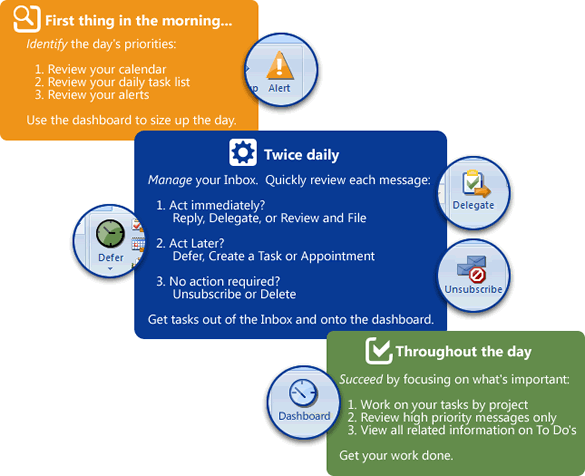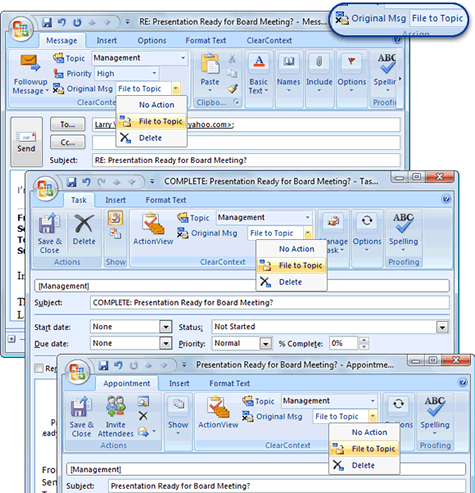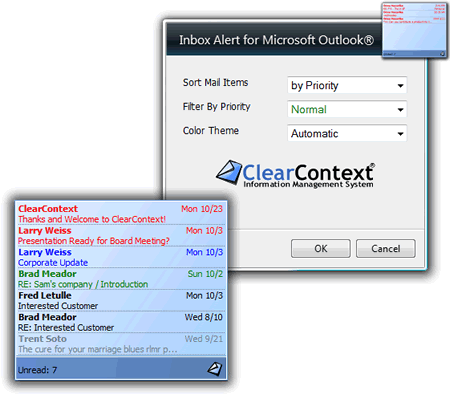 The ClearContext Daily Workflow is a three step process for managing Outlook that will save an hour or more per day. We developed these best practices in conjunction with productivity experts and our very passionate customer base to help overloaded individuals empty their inbox and get on top of their workday:
The ClearContext Daily Workflow is a three step process for managing Outlook that will save an hour or more per day. We developed these best practices in conjunction with productivity experts and our very passionate customer base to help overloaded individuals empty their inbox and get on top of their workday:

 First thing in the morning, identify the day's priorities:
First thing in the morning, identify the day's priorities:
- Review your calendar
- Review your daily task list
- Review your alerts
 Twice daily, manage your Inbox:
Twice daily, manage your Inbox:
Quickly review each message and determine when you need to act on it:
- Act immediately? Reply, Delegate, or Review and File
- Act later? Defer, Create a Task or Appointments
- No action required? Unsubscribe or Delete
 Throughout the day, succeed by focusing on what's important:
Throughout the day, succeed by focusing on what's important:
- Work on your tasks by project
- Review high priority messages only
- View all related information on To Do's
Over the next few days, we will review each step in more detail.
Posted by brad at 2:11 pm on September 8th, 2009.
Categories: daily_workflow, ims, tips.
The Identify phase of our IMS workflow takes place first thing in the morning and is your opportunity to size up the day before diving headlong into your email. It’s the time for you to make sure that you have your priorities in line so that you don’t lose sight of the day’s goals.
 You should also take this time to work on one or two of your most important tasks. By tackling one of those items that you absolutely have to get done before you start managing your day, you accomplish two things:
You should also take this time to work on one or two of your most important tasks. By tackling one of those items that you absolutely have to get done before you start managing your day, you accomplish two things:
- You ensure that no matter the number of fires you come across during the day, you knocked an important task off the list.
- You devote the time that is needed to address the task. If you put off your most important task until after you have gone through email, you may find that you haven’t left enough time to give it the proper attention it needs.
On the softer side, a rewarding sense of satisfaction permeates the day when you’ve taken one of your more important tasks out so early. Try it, you’ll like it.
Posted by brad at 5:23 pm on April 14th, 2008.
Categories: identify, ims.

One of the features that I use literally hundreds of times a day is Original Message filing. It has become such a critical part of my workflow that I find it maddening when I try to process mail without it.
As you reply to a message or create an appointment or task from the message, set Original Message to File To Topic. As you save the new item, IMS will automatically file the original message to it’s associated Topic folder. This saves an extra step when processing mail to clear the Inbox.

For more detail on this and other advanced Task and Calendar management features, see our video tutorial.
Posted by brad at 4:22 pm on April 7th, 2008.
Categories: ims, manage, tips.
Unless you work in a vacuum, you have tasks that you rely on others to complete. Whether you are expecting a response from a team member, partner or customer, the onus is on you to make sure that these tasks are completed in time to meet your own work goals. I use two tools to create these tasks – Followup Message and Delegate – and track both via the status field on Outlook tasks.
Followup Message
 Use Followup Message when sending a message that you need to hear back on. As you send the message, click the Followup Message button and set a time frame for the response you need. If you don’t hear back within the time specified, IMS will notify you. If you do hear back, the task will automatically be marked complete. You can also create a Followup task after the message has been sent by highlighting the sent message and selecting Followup Message from the ClearContext menu.
Use Followup Message when sending a message that you need to hear back on. As you send the message, click the Followup Message button and set a time frame for the response you need. If you don’t hear back within the time specified, IMS will notify you. If you do hear back, the task will automatically be marked complete. You can also create a Followup task after the message has been sent by highlighting the sent message and selecting Followup Message from the ClearContext menu.
Delegate
 Delegate converts email to either an Outlook delegated task (perfect for members of your internal team) or forwards an email and creates a personal task on your task list (better for external delegation). Delegate is accessed from the ClearContext menu. If you find that you use this feature a lot, you can add it to the Inbox toolbar. As you create a delegated task, assign a status of Waiting on someone else…
Delegate converts email to either an Outlook delegated task (perfect for members of your internal team) or forwards an email and creates a personal task on your task list (better for external delegation). Delegate is accessed from the ClearContext menu. If you find that you use this feature a lot, you can add it to the Inbox toolbar. As you create a delegated task, assign a status of Waiting on someone else…
Delegation Management
Since a status of Waiting on someone else… is assigned to both followups and delegated tasks, you can sort your task list by status and quickly glance at what has been delegated to others.
Posted by brad at 6:13 pm on March 31st, 2008.
Categories: ims, manage, tips.

Have you bought into the idea that you should only check email a couple of times a day, but you are worried that you will miss a really important message? Our Vista Gadget is designed for you.
- Download and install the gadget from here.
- Once it’s installed, click the wrench next to the gadget for configuration options.

- Select the priority you want to filter by from the Filter By Priority drop down. I suggest High or Very High.
- Click OK.
Now, when you’re ready to focus on your work for the day, select Do Not Disturb, minimize Outlook, and let the gadget tell you if a really important message arrives.
For more information on the gadget, see the ClearContext Inbox Alert User Guide.
Posted by brad at 11:31 am on March 24th, 2008.
Categories: ims, succeed, tips.
We pride ourselves on building a highly flexible Outlook Add-in that can be adapted to your individual email management process, whatever it may be. So, whether you’re a piler or a filer, there are features in IMS that will ultimately help you save many hours a week and reduce your email and job related stress. Along those lines, we continue to invest in new features to help both kinds of email users.
That said, I’m decidedly in the filer camp and start to feel some amount of anxiety when my Inbox has over 10 messages in it. Because of this, I find myself having a lot of interesting conversations with folks who are the polar opposite; people who begrudgingly empty their Inbox only when they have to due to size limitations.
It looks like Merlin Mann has encountered the same time of resistance, so he has posted his take on what to do if your organizational culture is such that you receive many long, conversational email threads throughout the day that require more than a few minutes of your time:
“Every time I give the Inbox Zero talk to a tech-heavy group — and most especially when I talk with engineers — there’s pushback on a couple issues. First, a lot of techies say they love it when everything gets routed through email, and second, they think an Inbox-Zero-type methodology isn’t particularly useful for the type of communication that they get all day long. And that’s conversations. Lots of conversations.”
For folks who match this description, Merlin has posted six tips that map very nicely to IMS features – threading, processing, filtering, standards, muting and save and search. It’s definitely worth taking a look if you’re still weighing whether emptying your Inbox will work for you. And if you do decide to take the plunge, see this post in intelligently emptying your Inbox.
Posted by brad at 1:21 pm on March 12th, 2008.
Categories: ims, manage, productivity.
Yesterday Jason Clarke at Download Squad published his take on clearing a bulging Inbox. His process, deemed Inbox 0.5, involves decreasing the number of messages in your Inbox by half every day until it’s cleared.
If the psychic weight of being an Inbox Piler is taking its toll, there are a number of similar recommendations for clearing your Inbox and getting to zero email bounce. In addition to Jason’s Inbox 0.5, there’s Merlin Mann’s Email DMZ (Michael Linenberger recommends a similar process) and Deva’s Ten a day plan.
All of these plans have their merits and I can attest that, whatever process you use, the feeling of relief you get when you keep your Inbox count low is well worth the effort. If you’re concerned that you’re going to drop some important messages when cleaning house, use a variant of our Vacation Email Triage recommendations to jumpstart the process and intelligently dump messages from the Inbox:
- Remove all low priority messages from the Inbox
- Use ClearContext IMS to prioritize your entire Inbox.
- Switch to the ClearContext Prioritized view (ClearContext > Inbox Views).
- Highlight all messages in gray. These messages are from unknown senders, are not addressed directly to you, and are likely spam.
- Delete all of these messages or alternatively move them to a processed mail folder if you are worried about missing something.
- If you really want to clean house, consider removing all messages in black as well. These are still from unknown senders and/or were not sent directly to you.
- Use AutoAssign to automatically categorize and file informational messages
- Highlight a newsletter or other informational letter in the Inbox.
- Select ClearContext > Create AutoAssign Rule from Message.
- Craft a rule that will assign a Topic and file to a Topic folder.
- Check Apply rule to Inbox messages now and click OK.
- Repeat for additional newsletters, corporate announcements, etc..
- Manage your Inbox, one conversation at a time
- Make sure are in a ClearContext Prioritized view. You may need to switch to Prioritized by Week or Prioritized by Day if you are finding stale messages at the top of the Inbox.
- Follow the steps in the Manage phase of the IMS Daily workflow to act on your remaining messages conversations. IMS will automatically group all message conversations together to ensure that you don’t repeat work that someone else has already completed.
Posted by brad at 1:33 pm on March 6th, 2008.
Categories: ims, manage, tips.
 Removing a Topic from the IMS Topic list is as easy as dragging and dropping a folder. IMS populates the Topic list by reading all sub-folders of the Inbox (or whatever you have defined as your ClearContext Topic Folder). To remove a Topic from the list, click the associated folder in the Inbox and drag it to another folder outside of the Inbox.
Removing a Topic from the IMS Topic list is as easy as dragging and dropping a folder. IMS populates the Topic list by reading all sub-folders of the Inbox (or whatever you have defined as your ClearContext Topic Folder). To remove a Topic from the list, click the associated folder in the Inbox and drag it to another folder outside of the Inbox.
Posted by brad at 12:09 pm on February 22nd, 2008.
Categories: ims, maintenance.
If you decide to rename your Topic folders (perhaps because you want to take advantage of multi-level Topics), follow the process below to ensure that IMS performs correct Topic assignments in the future:
- Go to ClearContext > Options > Preferences. Ensure that Assign message thread to Topic is enabled on both sections of "When I move a message to a Topic folder."
- Create a new Topic folder with the new Topic name.
- Drag the contents of the old Topic folder into the new Topic. This last step will ensure that IMS updates all active conversation threads with the new Topic. (FYI – CTRL-A will highlight all messages in a folder).
- Finally, if any items remain in the Inbox with the old Topic assignment, highlight and re-assign using the Topic drop down.
Posted by brad at 9:37 am on February 21st, 2008.
Categories: ims, maintenance.
Did you know that you can create a Topic/Sub-Topic designation that maps to Folder/Sub-Folder? To create multi-level topics, enter topic names separated by a "/". For example, filing to Topic "Work/Project" would store the message in the "Project" sub-folder underneath the "Work" main folder. This comes in handy when using the Dashboard’s Show Sub-Topics  feature.
feature.
Posted by brad at 7:29 am on February 20th, 2008.
Categories: ims, maintenance.
![]() The ClearContext Daily Workflow is a three step process for managing Outlook that will save an hour or more per day. We developed these best practices in conjunction with productivity experts and our very passionate customer base to help overloaded individuals empty their inbox and get on top of their workday:
The ClearContext Daily Workflow is a three step process for managing Outlook that will save an hour or more per day. We developed these best practices in conjunction with productivity experts and our very passionate customer base to help overloaded individuals empty their inbox and get on top of their workday:First thing in the morning, identify the day's priorities:
Twice daily, manage your Inbox:
Throughout the day, succeed by focusing on what's important:




 Use Followup Message when sending a message that you need to hear back on. As you send the message, click the Followup Message button and set a time frame for the response you need. If you don’t hear back within the time specified, IMS will notify you. If you do hear back, the task will automatically be marked complete. You can also create a Followup task after the message has been sent by highlighting the sent message and selecting Followup Message from the ClearContext menu.
Use Followup Message when sending a message that you need to hear back on. As you send the message, click the Followup Message button and set a time frame for the response you need. If you don’t hear back within the time specified, IMS will notify you. If you do hear back, the task will automatically be marked complete. You can also create a Followup task after the message has been sent by highlighting the sent message and selecting Followup Message from the ClearContext menu. Delegate converts email to either an Outlook delegated task (perfect for members of your internal team) or forwards an email and creates a personal task on your task list (better for external delegation). Delegate is accessed from the ClearContext menu. If you find that you use this feature a lot, you can
Delegate converts email to either an Outlook delegated task (perfect for members of your internal team) or forwards an email and creates a personal task on your task list (better for external delegation). Delegate is accessed from the ClearContext menu. If you find that you use this feature a lot, you can 
 Removing a Topic from the IMS Topic list is as easy as dragging and dropping a folder. IMS populates the Topic list by reading all sub-folders of the Inbox (or whatever you have defined as your
Removing a Topic from the IMS Topic list is as easy as dragging and dropping a folder. IMS populates the Topic list by reading all sub-folders of the Inbox (or whatever you have defined as your